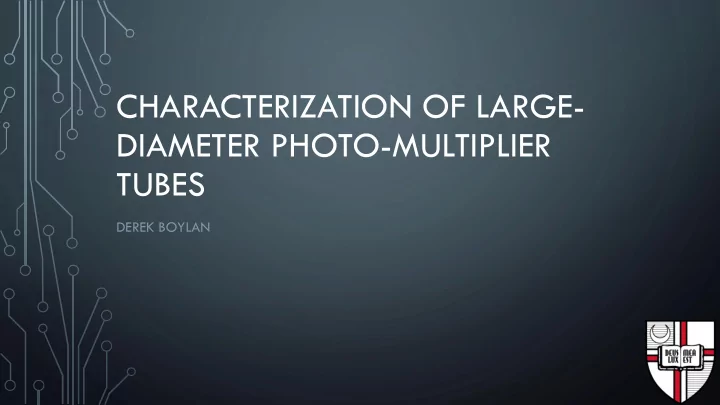

CHARACTERIZATION OF LARGE- DIAMETER PHOTO-MULTIPLIER TUBES DEREK BOYLAN
PHOTO-MULTIPLIER TUBES (PMTS) • Photomultipler tubes are vacuum- tight light detectors • Can detect single photons • Useful in particle detectors like those in Jefferson Laboratories and CERN XP4500/B PMT, used in detectors like Cherenkov detector at JLab Photo by Derek Boylan
HOW A PMT WORKS • The front-facing photo-cathode in the PMTs at Catholic University creates a flow of electrons when struck by light due to the low work function of the face • This current is then amplified through a series of dynodes which create a cascade of electrons • The anode collects the current, which can be transferred to a computer through an analog to digital convertor https://c2.staticflickr.com/4/3653/3681701585_8545d2d15a.jpg
CHERENKOV RADIATION DETECTOR • PMts used in Cherenkov radiation detectors. • Hadronic particles that pass through detectors at Jefferson lab are categorized based on the angle at which Cherenkov radiation is refracted • PMTs help determine whether particles are Pions, Kaons, or Protons Picture by Bert Metzger (from CUA wiki)
PURPOSE OF CHERNKOV DETECTOR • With 12 GeV at Jefferson Laboratories, new insight can be gained about hadronic structure through kaon production. • Hadronic degrees of freedom is an area of interest that Cherenkov detectors can help unearth
PURPOSE OF CHARACTERIZING PMTS • One important characteristic of PMTs is their uniformity • Without a uniform lens, some Cherenkov Radiation that made contact with a lens may not appear the same throughout • The more uniform a PMT, the more accurate the data collected at Jefferson Laboratories becomes
PMT SCANNING • Uniformity test using a collimated blinking LED, a two axis motor, and a PMT • This test allows one to graphically depict the number of photoelectrons the lens of the PMT receives
PRELIMINARY SCANNING OF XP4500 • Poor results, irregular patterns of lens, poor gain in certain areas • Diagnosis was that something was wrong with the scanning method, or some part of the PMT was faulty
FURTHER TROUBLESHOOTING • Tested the XP4572 PMT with similarly poor results • Tested only 5 months ago and worked fine, therefore, concluded that something was wrong with the experimental setup and not the PMT itself
SWITCHED BASES • After switching bases, the pictures resumed their original clarity • Setup amended, scanning could continue • Possible cause: base was not distributing high voltage to every component
PHOTONIS XP4572/B • PMT used to troubleshoot the scanning setup as the very same PMT had been scanned before in February of this year
PHOTONIS XP4500/B/D1 • PMT currently used in Cherenkov detector at Jlabs • Mainly uniform surface, some areas of low gain where there is a lining on the photo cathode face
HAMAMATSU R1584 • More costly PMT that can detect lower wavelengths of light than the Photonis XP 4500 • If more uniform, could be a better suited PMT for the Cherenkov detectors at JLab
GAIN TESTING OF HAMAMATSU R1584 • In order to measure the gain of a PMT, the minimum amount of light was exposed to the PMT so that only single electrons were being displaced • By measuring this data, the pedestal (background noise) and single electron peak, as well as the difference between those values, was measured
HAMAMATSU ANALYSIS • Similar results to previous PMTs that had irregular patterns on their surfaces • Could be another case of a base not distributing charge correctly
ANALYSIS OF R1584 • Nonuniform face • Could be a result of a bad base – not distributing charge • Current results demonstrate that there is no need to upgrade to this PMT due to nonuniformity of R1584
FUTURE WORK • Gain testing of XP4500 to compare the photoelectron count of both (has been done in the past, but variables could have changed • More testing of Hamamatsu with different base and higher intensity of light (causing more photoelectrons to be displaced) • More testing of XP4500 to verify previous results • Modeling of experiment and calorimeter
ACKNOWLEDGEMENTS I would like to thank Dr. Tanja Horn, Marco Carmignotto, Indra Sapkota, Bijay Nepal, and Joel for their help and guidance as I conducted research. Additionally, I would like to thank my fellow interns, Stephanie Durham, Alex Dittman, Will Lash, and Buffy Parvatam for their help. Finally, I would like to thank Catholic University of America for allowing me to conduct research here over the summer.
Recommend
More recommend